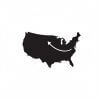



Queen Elizabeth II 25th Anniversary Coronation First Day Cover, St. Christopher-Nevis-Anguilla postmarked on June 2, 1978.
St. Christopher-Nevis-Anguilla
This volcanic, oval-shaped island in the Leeward group was first settled in 1623 by the British, although the Carib Indians had been there before. The familiar Caribbean pattern of sugar and cotton plantations worked by African slaves was soon established, jointly with French settlers. Resistance played its relentless part in slavery's abolition, and even the burning alive and quartering of rebel slaves who had ensconsed themselves in a fort did nothing but speed the day. The population now is primarily of African descent, but much of the farmland is still in the form of sugar and cotton plantations owned by the European minority, many of whom do not live on the island.
The local beast in this Omnibus issue is the Pelican, which fishes mostly by ducking its head while surface swimming. Its close relatives play complementary ecological roles; the cormorants fish while swimming underwater, the boobies are expert dive bombers, and the frigates are adept pirates. However, feeding on inland and coastal waters, the pelicans accumulate insecticide residues. This causes their eggs to have shells so thin that they break before hatching. In direct consequence, pelicans along the Californian coast are now unable to breed.
The bird's symbolic use in Mediaeval church architecture derives from an Egyptian fable of a mother pelican feeding her children on her blood, just as Christianity has Christ redeeming his flock with his own blood.
The Falcon is associated with Edward I because of its heraldic use by two of his sons and the existence in 1359 of a Falcon King of Arms. The Falcon was symbolically identical with the eagle, carrier of both Indra's and Jupiter's thunderbolts, and their messages. Being also the natural enemy of the serpent, this made it appropriate for incorporation into the christian mythos, appearing as the church lectern eagle. As a symbol of power and fearlessness, it came to be the exclusive standard of Roman armies, and is still used as the national emblem of the United States. In this form it reflects the concept of man as master of his environment, from which the holistic concept of man as part of the environment is only now re-emerging. Modern ecology is one example of this view.
Shipping:
-
We ship via USPS, UPS or FedEx. At this time, we do not offer shipping to addresses with an APO/FPO or outside the continental United States.
Shipping Time:
Orders are normally shipped from our warehouse within 24 - 48 business hours of order placement. Please allow 7 - 10 business days for delivery after your order has shipped. Delivery times are estimated and we do not provide money-back guarantee for any shipping option other than FedEx Express or UPS Next Day.
Terms of Use and Security
-
We use cookies to store visitors preferences, record session information, such as items that consumers add to their shopping cart, record user-specific information on what pages users access or visit, alert visitors to new areas that we think might be of interest to them when they return to our site. If you do not want to receive e-mail from us in the future, please let us know by sending us an e-mail. If you supply us with your postal address on-line you may receive periodic mailings from us with information on new products, special pricing and services or upcoming events. If you do not wish to receive such mailings, let us know by sending us an e-mail. Please provide us with your exact name and address. Persons who supply us with their telephone numbers on-line will only receive telephone contact from us with information regarding orders they have placed on-line. With respect to security: We have appropriate security measures in place in our physical facilities to protect against the loss, misuse or alteration of information that we have collected from you at our site. If you feel that this site is not following its stated information policy, you may contact us at your discretion.
Returns & Replacements
-
We accept returns within 30 days of the date of purchase unless otherwise stated on the item's page. In order to return an item, please contact us for a Return Authorization Number. Once the Return Authorization Number is acquired, you have 30 days to return the item(s). All returned items must be unused and in new condition in their original packaging including all hardware and instructional components. Items are also subject to a 20% restocking fee. Although if you are a repeat customer who purchased from our website before, we are happy to waive the restocking fee.
Any returned item deemed not to fall within the preceding criteria will be returned with no credit issued at the customer's expense. Once your return has been inspected please allow 15 days for the credit to be applied to the credit card used for purchase. The initial cost of shipping is not eligible for a refund. Buyer pays for return shipping. To request your Return Authorization Number, please follow these steps:
-
1. Read and agree to the Returns Policy and Procedure above.
-
2. Email us at cs@phenomstores.com. We will need your order number and the Item ID number of the product you wish to return.
Refused Orders - Should you decide that you wish to refuse receipt of an item when delivered by UPS, USPS or any other common carrier and legitimately ordered from us, credit will be issued for the item, minus shipping and a restocking charge of 20%.Exchanges - In order for us to do the exchange we would need to refund your payment, then you would need to make another purchase transaction with us for the item that you like within 7 days of your exchange request. We're asking that you return the item you bought from us within 30 days along with a tracking number so we both know that your return reached us. We are not responsible for lost or stolen items. All returned items must be unused and in new condition in their original packaging including all hardware and instructional components. Any returned item deemed not to fall within the preceding criteria will be returned with no credit issued at the customer's expense. You are responsible for the return shipping cost. We also charge a 10% restocking fee for exchanges. Once we received and inspected the item we will credit** your payment. Please take note, our inventory changes constantly so the item may not be available at the time of your request.
**A store credit will be issued on orders returned totaling less than $5.
Damaged, Defective and Wrong Item(s) - It is your responsibility that the item(s) you received are undamaged and the correct item(s). Please examine the shipping box and all contents immediately upon receipt for any signs of damage, defect or wrong item(s). All claims must be initiated within 7 days of delivery and send us an email so we can further assist you.
Still have questions? Please don't hesitate to contact us by sending us an email to cs@phenomstores.com or by phone at 608-571-7033.
FAQ
When do I expect my order to ship out?
Our normal shipping lead times can take up to 72 hours after your order is received. However, due to unprecedented demand brought on by COVID-19 our shipping times have been extended. This is due to logistical issues that our shipping carriers are experiencing that is outside our control. Rest assured, we're doing everything we can to ship your order as soon as it's received.
How will I know my order has shipped?
As soon as your order is packed and labeled, we will email you a shipment confirmation with the tracking number so that you're able to track your order. You can look up the status of your order by entering the tracking number found on the bottom of our web page under "Track Order Status". You can also look up the shipment status of your order by entering your shipment tracking number at USPS.com, UPS.com or FedEx.com.
How much does shipping cost?
Our shipping costs vary depending on the item you're purchasing. Most items are eligible for our FREE shipping if your purchase totals $59 and over. And for items that are excluded from FREE shipping like bulk or oversized items, we offer FIXED shipping rate or prevailing market prices.
Some of the items I ordered are missing. What should I do?
Please reach out to us when you have items that are missing when you originally placed your order. This happens either because,
1. The missing items are on backorder or
2. The missing items are still on its way but due to service delays from our shipping carrier (ie UPS, FedEx) your package may take longer than expected.
How soon after can I cancel my order?
Unfortunately, we cannot cancel an order once an order is placed. This is because your order is automatically placed in queue to ship out once an order is received.
What is the best way to reach you when I have a question?
Our customer service phone and chat lines are normally open from 8:30 am to 5:30 pm CST. However, there are times when we can't be reached because all our customer service agents are helping other customers. If this happens, please leave us a voicemail at 608-571-7033 or write us a message on our "Contact Us" page and we will get back to you as soon as possible.
What happens when I "Pre-Order" an item?
When you "Pre-Order" an item that is out of stock, you will be notified when we have the item in stock again. Our "Pre-Order" (or Wait-List) doesn't guarantee that your order will be fulfilled but we will do our best to make that happen.
You're also under NO obligation to purchase when you sign up for "Pre-Order".



